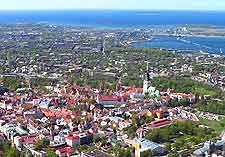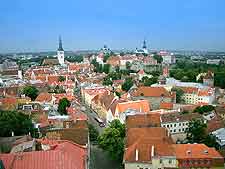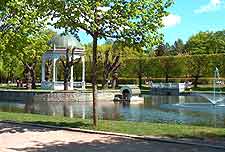Tallinn Neighbourhoods, Locations and Districts
(Tallinn, Harjumaa, Estonia)

Tallinn is split into a total of eight administrative districts, Haabersti, Kesklinn, Kristiine, Lasnamäe, Mustamäe, Nomme, Pirita and Pohja-Tallinn, of which Lasnamäe is by far the biggest, featuring a population of more than 100,000 residents. These administrative districts are then further divided into a series of regions and neighbourhoods, and it is a number of these areas in particular that are of interest to tourists visiting Tallinn.
Old Town Tallinn resides within the district of Kesklinn, along with the suburban areas of the port, while Pirita is known for its large parklands, botanical gardens and beachfront, where water sports are popular. Pohja-Tallinn also has a special place in the hearts of tourists, since it features a series of historical wooden buildings and houses, and is also home to the train station. Many of these other regions are predominantly residential or industrial. The following neighbourhoods and districts of Tallinn are of most interest to tourists.

Old Town
The beautiful Old Town area has long been the main draw card in Tallinn and tourists flock to this beautiful part of the city. Many of the buildings within the Old Town were built in the 15th century and remain in good order, being heritage-listed. Viru Gate is a popular part of Old Town Tallinn and contains one of the city's biggest selection of shops. The district contains many interesting places to meet and the central square is the true heart of the city, being surrounded by endless eateries and home to the Town Hall (Raekoda), which was built towards the end of the 14th century. Other highlights include the Danish Castle, the Alexander Nevsky Cathedral and the Riigikogu parliament buildings.
City Centre
Tallinn city centre is where you will find many of the city's most modern structures, shopping streets and hotels, along with some 19th-century gems and trendy dining areas. The city centre features a developed public transport infrastructure and offers plenty to do when the sun goes down.

Kadriorg District
A popular seaside resort with plenty of coastal attractions, Kadriorg is an elegant part of eastern Tallinn and features both historic villas and more modern apartments, along with a series of wooden buildings from as early as the 18th century. Areas of Kadriorg also boast a noticeable Art Deco influence, while the main highlight is without doubt the magnificent Kadriorg Palace and Gardens, which dominate much of the area.
Kalamaja District
Kalamaja is the most historic suburban district of Tallinn and this neighbourhood dates back as far as the 14th century. Located on the north-western side of the Old Town and close to the seafront, Kalamaja was once filled with fisherman, although today some parts are rather run down, however, the many 19th-century wooden buildings are worth a look.
Rottermann Quarter
Although parts of the Rottermann Quarter are industrial, there is much here for tourists and the cultural aspect of the neighbourhood has developed greatly in recent years. The up-and-coming Rottermann Quarter lies between the Old Town, Tallinn's new city centre and also the harbour, and is now home to a range of restaurants, bars, nightclubs and shopping areas, with many of the buildings retaining their original facade, such as the old granary.
 Tallinn is split into a total of eight administrative districts, Haabersti, Kesklinn, Kristiine, Lasnamäe, Mustamäe, Nomme, Pirita and Pohja-Tallinn, of which Lasnamäe is by far the biggest, featuring a population of more than 100,000 residents. These administrative districts are then further divided into a series of regions and neighbourhoods, and it is a number of these areas in particular that are of interest to tourists visiting Tallinn.
Tallinn is split into a total of eight administrative districts, Haabersti, Kesklinn, Kristiine, Lasnamäe, Mustamäe, Nomme, Pirita and Pohja-Tallinn, of which Lasnamäe is by far the biggest, featuring a population of more than 100,000 residents. These administrative districts are then further divided into a series of regions and neighbourhoods, and it is a number of these areas in particular that are of interest to tourists visiting Tallinn.
